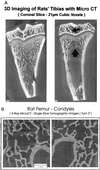Estrogen regulates the rate of bone turnover but bone balance in ovariectomized rats is modulated by prevailing mechanical strain
- PMID: 9108129
- PMCID: PMC20601
- DOI: 10.1073/pnas.94.8.4199
Estrogen regulates the rate of bone turnover but bone balance in ovariectomized rats is modulated by prevailing mechanical strain
Abstract
Estrogen deficiency induced bone loss is associated with increased bone turnover in rats and humans. The respective roles of increased bone turnover and altered balance between bone formation and bone resorption in mediating estrogen deficiency-induced cancellous bone loss was investigated in ovariectomized rats. Ovariectomy resulted in increased bone turnover in the distal femur. However, cancellous bone was preferentially lost in the metaphysis, a site that normally experiences low strain energy. No bone loss was observed in the epiphysis, a site experiencing higher strain energy. The role of mechanical strain in maintaining bone balance was investigated by altering the strain history. Mechanical strain was increased and decreased in long bones of ovariectomized rats by treadmill exercise and functional unloading, respectively. Functional unloading was achieved during orbital spaceflight and following unilateral sciatic neurotomy. Increasing mechanical loading reduced bone loss in the metaphysis. In contrast, decreasing loading accentuated bone loss in the metaphysis and resulted in bone loss in the epiphysis. Finally, administration of estrogen to ovariectomized rats reduced bone loss in the unloaded and prevented loss in the loaded limb following unilateral sciatic neurotomy in part by reducing indices of bone turnover. These results suggest that estrogen regulates the rate of bone turnover, but the overall balance between bone formation and bone resorption is influenced by prevailing levels of mechanical strain.
Figures






Similar articles
-
Mechanical signaling in the development of postmenopausal osteoporosis.Lupus. 1999;8(5):388-92. doi: 10.1177/096120339900800512. Lupus. 1999. PMID: 10455519 Review.
-
The effects of orbital spaceflight on bone histomorphometry and messenger ribonucleic acid levels for bone matrix proteins and skeletal signaling peptides in ovariectomized growing rats.Endocrinology. 1997 Apr;138(4):1567-76. doi: 10.1210/endo.138.4.5040. Endocrinology. 1997. PMID: 9075717
-
Additional weight bearing during exercise and estrogen in the rat: the effect on bone mass, turnover, and structure.Calcif Tissue Int. 2006 Dec;79(6):404-15. doi: 10.1007/s00223-006-0045-z. Epub 2006 Dec 8. Calcif Tissue Int. 2006. PMID: 17160577
-
Programmed administration of parathyroid hormone increases bone formation and reduces bone loss in hindlimb-unloaded ovariectomized rats.Endocrinology. 1998 Oct;139(10):4086-91. doi: 10.1210/endo.139.10.6227. Endocrinology. 1998. PMID: 9751486
-
Hindlimb unloading of growing rats: a model for predicting skeletal changes during space flight.Bone. 1998 May;22(5 Suppl):83S-88S. doi: 10.1016/s8756-3282(98)00019-2. Bone. 1998. PMID: 9600759 Review.
Cited by
-
Failure to generate bone marrow adipocytes does not protect mice from ovariectomy-induced osteopenia.Bone. 2013 Mar;53(1):145-53. doi: 10.1016/j.bone.2012.11.034. Epub 2012 Dec 12. Bone. 2013. PMID: 23246792 Free PMC article.
-
Effects of Spaceflight on Bone Microarchitecture in the Axial and Appendicular Skeleton in Growing Ovariectomized Rats.Sci Rep. 2015 Dec 22;5:18671. doi: 10.1038/srep18671. Sci Rep. 2015. PMID: 26691062 Free PMC article.
-
Spaceflight-induced vertebral bone loss in ovariectomized rats is associated with increased bone marrow adiposity and no change in bone formation.NPJ Microgravity. 2016 Apr 28;2:16016. doi: 10.1038/npjmgrav.2016.16. eCollection 2016. NPJ Microgravity. 2016. PMID: 28725730 Free PMC article.
-
Increased nitric oxide-mediated vasodilation of bone resistance arteries is associated with increased trabecular bone volume after endurance training in rats.Bone. 2010 Mar;46(3):813-9. doi: 10.1016/j.bone.2009.10.029. Epub 2009 Nov 3. Bone. 2010. PMID: 19892040 Free PMC article.
-
Oxidative-mechanical stress signals stem cell niche mediated Lrp5 osteogenesis in eNOS(-/-) null mice.J Cell Biochem. 2012 May;113(5):1623-34. doi: 10.1002/jcb.24031. J Cell Biochem. 2012. PMID: 22359381 Free PMC article.
References
-
- Richelson L S, Wahner H W, Melton L J, Riggs B L. N Engl J Med. 1984;311:1273–1275. - PubMed
-
- Lindsay R, Hart D M, Forrest C, Baird C. Lancet. 1980;ii:1151–1154. - PubMed
-
- Compston J E, Yamaguchi K, Croucher P I, Garrahan N J, Lindsey P C, Shaw R W. Bone. 1995;16:261–267. - PubMed
-
- Turner R T, Riggs B L, Spelsberg T C. Endocr Rev. 1994;15:275–300. - PubMed
Publication types
MeSH terms
Substances
Grants and funding
LinkOut - more resources
Full Text Sources

